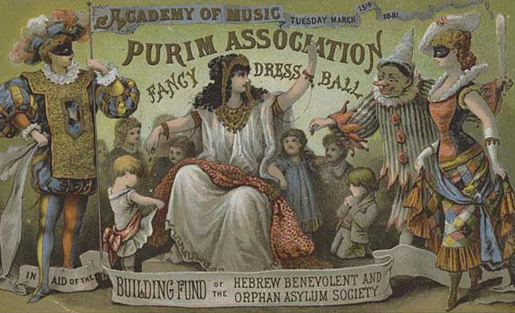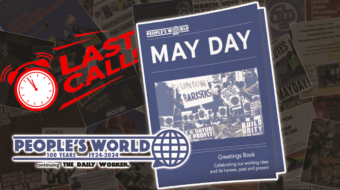
Purim is celebrated as one of the most joyous and fun holidays on the Jewish calendar, the closest Jewish equivalent to Halloween. It commemorates a time in the year 357 BCE when the Jewish people living in Persia were saved from extermination. This year, the Jewish year 5776, it falls on the night of Wednesday, March 23 and the following day (the Jewish day begins at sundown).
The story of Purim is told in the Biblical book of Esther. The heroes of the story are Esther, a beautiful young Jewish woman living in Persia (just in time for Women’s History Month!), and her cousin (or uncle) Mordechai, who raised her. Esther was taken to the house of Ahasuerus, King of Persia, to become part of his harem. King Ahasuerus loved Esther more than his other women and made Esther queen, but the king did not know that Esther was a Jew, because Mordechai told her not to reveal her identity.
The villain of the story is Haman, an arrogant, egotistical advisor to the king. Haman hated Mordechai because Mordechai refused to bow down to Haman, so Haman plotted to destroy the Jewish people. In a speech that is all too familiar to Jews, Haman told the king, “There is a certain people scattered abroad and dispersed among the peoples in all the provinces of your realm. Their laws are different from those of every other people’s, and they do not observe the king’s laws; therefore it is not befitting the king to tolerate them” (Esther 3:8). The king gave the fate of the Jewish people to Haman, to do as he pleased to them. Haman planned to exterminate all of the Jews.
Mordechai persuaded Esther to speak to the king on behalf of the Jewish people. This was dangerous, because anyone who came into the king’s presence without being summoned could be put to death, and she had not been summoned. Esther fasted for three days to prepare herself, then went to the king. He welcomed her. She told him of Haman’s plot against her people, the Jewish people were saved, and Haman and his ten sons were hanged on the gallows that had been prepared for Mordechai.
The book of Esther is unusual in that it is the only book of the Bible that does not contain the name of God. Secular Jews embrace Purim believing it to be proof that deliverance is not the work of a supernatural being, but of earthbound human effort. God-fearing Jews of course interpret the message of the story to be that God often works in ways that are not apparent, that appear to be chance, coincidence or ordinary good luck.
And then there’s the dark side…
But the story continues with a final coda: The Jews of Persia were issued a decree by Queen Esther and Mordechai, with King Ahasuerus’ approval, giving them permission to rise up against the forces that Haman had mustered to destroy them. According to the Book of Esther, seventy-five thousand souls were killed by the Jews:
“The Jews gathered themselves together in their cities throughout all the provinces of the king Ahasuerus, to lay hand on such as sought their hurt, and no man could withstand them; for the fear of them fell upon all people…. And all the rulers of the provinces, and the lieutenants, and the deputies, and officers of the king, helped the Jews; because the fear of Mordechai fell upon them…. Thus the Jews smote all their enemies with the stroke of the sword, and slaughter, and destruction, and did what they would unto those that hated them” (Esther, 9:2-9:5).
The mass killings of Haman’s followers by Jews are almost never focused on. “We don’t talk about that,” observes Peter Beinart, former editor of the New Republic, in his forthright book, The Crisis of Zionism, “because we begin our stories with victimhood and end them with survival.” The key question facing Jews today, however, is how we contend not with victimhood but with power, says Beinart. “The shift from Jewish powerlessness to Jewish power has been so profound, and in historical terms so rapid, that it has outpaced the way many Jews think about themselves.”
Yet “perpetual victimhood is not a narrative that can…sustain Judaism in America, a country that makes it easy for Jews to stop being Jews,” nor can it “sustain democracy in Israel, a country that for two-thirds of its existence has held the West Bank, a territory where its democratic ideals do not apply.”
In a horrific intentional echo of the dark side of the Purim tale, Baruch Goldstein, a Brooklyn-born Orthodox Jewish physician, murdered 29 Palestinians and wounded 125 others by opening fire in a mosque in the Cave of the Patriarchs in Hebron, a city in the West Bank, on the Purim holiday in 1994. Goldstein was attacked and killed by survivors of the massacre. His grave in Meir Kahane Memorial Park in Hebron has become a site of veneration for extremist nationalist settlers, with a plaque praising “the holy Baruch Goldstein, who gave his life for the Jewish people, the Torah and the nation of Israel.” Goldstein was a charter member of the Jewish Defense League and a dyed-in-the-wool racist; four years before the massacre, an Israeli intelligence agent who had infiltrated Kahane’s Kach movement had warned his superiors about Goldstein.
As with all fundamentalist and fanatical believers, it depends which passages of the Bible you interpret to support your ideology. The Baruch Goldstein forces are still very much among us.
Traditional Purim festivities emphasize the historic struggle of a people for survival and pride, and this takeaway from the holiday can certainly not be forgotten. Young children dress up as characters in the Esther story, and both children and adults participate in “Purimshpils,” original topical skits that act out the story but with contemporary references, such as to the death penalty. This electoral year the opportunities for parody are rich: Surely someone somewhere this year will include a song adaptation, “Trump, Trump, Trump, the boys are marching.”
Adapted from Jewish Currents, Judaism 101, and other sources.












Comments